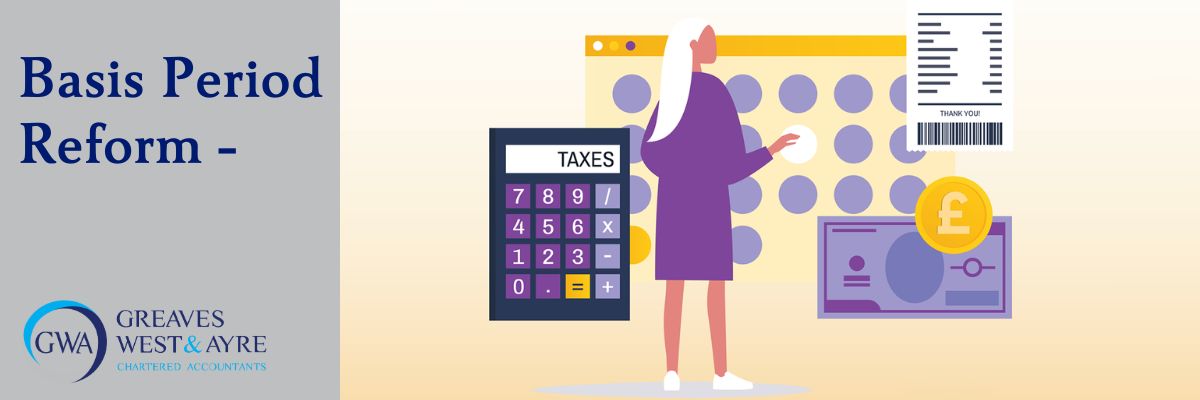Basis Period Reform

Basis Period Reform:
Will it affect your business?
Under current UK tax rules, unincorporated businesses (such as the self-employed, sole traders and members of partnerships) are not required to produce accounts by a particular date: they can choose any accounting date they like. They are then usually taxed on profits or losses that arise in the 12-month accounting period (the basis period) up to the accounting date which falls in a tax year. This is known as the ‘current year basis’.
For example, suppose you are a Sole Trader who prepares your accounts annually to 30 September. For the 2022/23 tax year, your basis period for working out your tax liability was your profits/losses for the 12 months up to 30 September 2022.
HMRC is reforming the tax rules by moving from the ‘current year basis’ system to a new ‘tax year basis’ system therefore effectively breaking the link between the accounting date chosen by a business and when they are taxed on their profits. This means that unincorporated businesses will be taxed on profits arising in the tax year, rather than on their accounting year, regardless of their period of accounts. This aligns the taxation of trading income with that of untaxed non-trading income (e.g. untaxed income from property, interest or dividends).
The new tax year basis will apply from 2024/25 with a transitional year being 2023/24. It affects all unincorporated businesses who do not have 31 March / 5 April accounting year-ends. If your unincorporated business does not have a year end of 31 March or 5 April, for the 2024/25 tax year you will be required to apportion profits or losses across periods of accounts to adjust your results to the tax year basis.
Transitional year – year to 5 April 2024
The 2023/24 tax year will be a transitional year with specific tax rules. During this year, the basis period for continuing businesses will be the 12 months to the end of the accounting period ending within 2023/24 plus the period up to the end of the tax year.
For our Sole Trader, this means for 2023/24 the basis period is all of the profit for the 12 months up to 30 September 2023 (“standard part”) plus ⁶/₁₂ of profits for the period of account up to 30 September 2024 (“transitional part”). This could mean significantly higher tax bills for that year, perhaps even pushing some people into a higher tax bracket.
To alleviate the tax impact of additional profits brought into account, taxpayers can deduct any overlap relief brought forward from their transition part profits, and spread any remaining ‘transition profits’ over up to five years. It is also possible that the business has other income sources that is taxed per the accounting period. This may include rental income or untaxed bank interest. Please note that for these sources of income, the transitional rules also apply, but there is no mechanism to spread these profits over the five year period. Once again, this may lead to increased taxable profits in the 2023/24 tax year.
Overlap relief
Overlap relief may have arisen when the business started to trade (when the current year basis meant they may have been taxed twice on the same profits) or from a past change in accounting date. If the business is old enough, it may also have transitional overlap relief available from the switch over to the current year basis in 1996/97.
Any loss arising in the transition part will be automatically set against the standard part profits, and vice versa. If a loss arises in both the transition part and standard part, these losses are combined for the purposes of calculating the overall loss for 2023/24.
Year to 5 April 2025
If we consider the above Sole Trader example again, for 2024/25 – the apportion would be ⁶/₁₂ of the profits for the period of account up to 30 September 2024 plus ⁶/₁₂ of profits for the period of account up to 30 September 2025.
This of course means that if the accounts to 30 September 2025 are not finalised, 6 months’ profits/losses will have to be estimated for the submission of the 2024/25 tax return and the tax return subsequently amended once the accounts are finalised. Working out estimates and submitting a second return will cause an additional administrative burden. In addition, for some businesses, for example seasonal or farming businesses, accurate estimates will be very difficult to make.
HMRC will allow provisional figures to be corrected by amending the original return. Generally, where a provisional figure is included in a return, it should be corrected immediately once the final figure is known. However, HMRC have indicated they will amend their guidance, and allow provisional figures used because of basis period reform to be corrected at any time up to the normal amendment deadline. For example, for tax year 2024/25, a business will have until 31 January 2027 to correct a provisional figure. This should allow agents and businesses to file the amended return at the same time as preparing the following year’s return.
Making Tax Digital
How will the basis period reform interact with Making Tax Digital? Making Tax Digital for Income Tax Self-Assessment (MTD for ITSA) will be introduced from April 2026 for businesses with turnover of £50,000 or more, and from April 2027 for those turning over at least £30,000. Taxpayers in the scope of MTD ITSA will have to submit quarterly updates of their income and expenses to HMRC. These quarterly updates will align with the tax year, and not the accounting period of the business.
The introduction of the tax year basis from April 2024 may make alignment with MTD for ITSA quarters easier. However, it should be remembered that, if the business does not have a 31 March or 5 April year-end, then under the tax year basis it is not the transactions actually taking place in the tax year which are subject to tax, but rather the apportioned profits of the relevant accounting periods (see above).
In summary, if your business is unincorporated and your accounting date is not aligned with the end of the tax year, basis period reforms will affect you and could affect your cash flow. You may wish to discuss changing your accounting year-end to 31 March or 5 April to reduce the administrative burden and give more accurate figures for tax purposes. The prospect of higher tax bills in January 2025 might also prompt tax planning, such as making pension contributions. Any contributions would have to be made in the current tax year (i.e. before 6 April 2024) when the taxable profits will not have been computed.
We appreciate that this is not the easiest of subjects to explain. We will continue to review HMRC guidance and provide updates with proactive, and hopefully easy to understand advice, where needed. In the meantime, if you would like to discuss or clarify any of the issues raised, please do not hesitate to get in touch.


